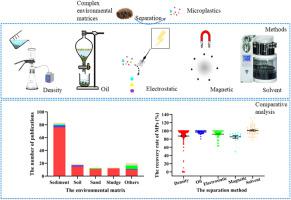Journal of Hazardous Materials ( IF 12.2 ) Pub Date : 2020-11-20 , DOI: 10.1016/j.jhazmat.2020.124640 Defu He , Xiaoting Zhang , Jiani Hu

|
Microplastics (MPs) are widely found in complex solid matrices such as soil, sediments and sludge. The separation procedure is crucial for effective analysis of MPs, but existing methods varied among studies. Here, we systematically summarize and compare separation methods including density, oil, electrostatic, magnetic, and solvent extraction separation. Density separation is the most commonly used approach, but time-consuming and discharging hazardous materials dependent on extraction solutions. In contrast, oil, electrostatic, magnetic separation and solvent extraction separation are emerging approaches with advantages of low-cost, quick, or environmentally-friendly, but with high request of instruments. Despite variation among these approaches, the separation efficiency is closely related to characteristics of MPs including polymer types, sizes and shapes. The treatment of digestion and fluorescence staining can facilitate the detection of MPs. This analysis suggests that further optimization and improvement of existing approaches can facilitate the development of new separation technology for assaying MPs in complex environmental matrices.
中文翻译:

从复杂固体基质中分离微塑料的方法:比较分析
在复杂的固体基质(例如土壤,沉积物和淤泥)中广泛发现了微塑料(MPs)。分离程序对于有效分析MP至关重要,但现有方法因研究而异。在这里,我们系统地总结和比较了分离方法,包括密度,油,静电,磁性和溶剂萃取分离。密度分离是最常用的方法,但是耗时和排放有害物质的方法取决于萃取溶液。相反,油,静电,磁分离和溶剂萃取分离是新兴的方法,具有低成本,快速或环境友好的优点,但对仪器的要求很高。尽管这些方法有所不同,但分离效率与MP的特性(包括聚合物类型,大小和形状。消化和荧光染色的处理可以促进MP的检测。该分析表明,对现有方法的进一步优化和改进可以促进用于分析复杂环境基质中MP的新分离技术的发展。











































 京公网安备 11010802027423号
京公网安备 11010802027423号